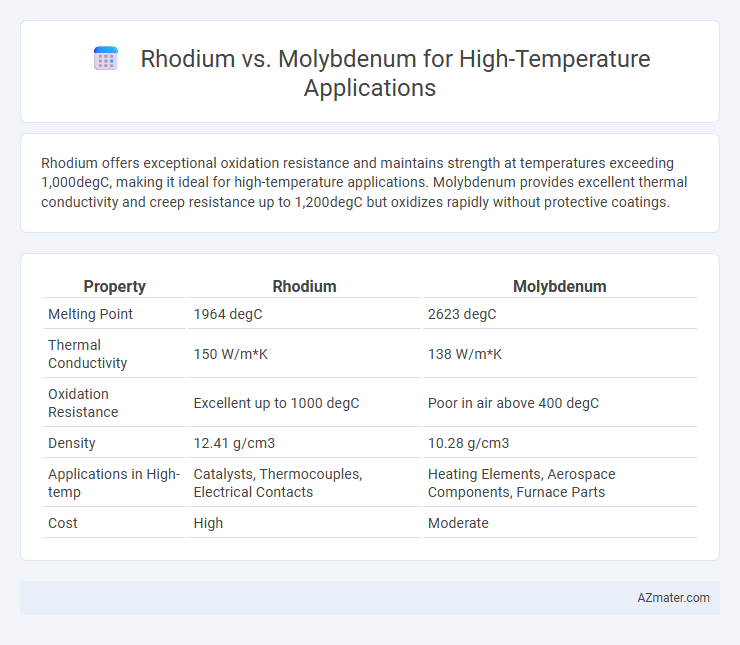Rhodium offers exceptional oxidation resistance and maintains strength at temperatures exceeding 1,000degC, making it ideal for high-temperature applications. Molybdenum provides excellent thermal conductivity and creep resistance up to 1,200degC but oxidizes rapidly without protective coatings.
Table of Comparison
| Property | Rhodium | Molybdenum |
|---|---|---|
| Melting Point | 1964 degC | 2623 degC |
| Thermal Conductivity | 150 W/m*K | 138 W/m*K |
| Oxidation Resistance | Excellent up to 1000 degC | Poor in air above 400 degC |
| Density | 12.41 g/cm3 | 10.28 g/cm3 |
| Applications in High-temp | Catalysts, Thermocouples, Electrical Contacts | Heating Elements, Aerospace Components, Furnace Parts |
| Cost | High | Moderate |
Introduction to High-Temperature Materials
High-temperature materials like rhodium and molybdenum are critical for applications demanding exceptional thermal stability and resistance to oxidation. Rhodium exhibits superior corrosion resistance and maintains mechanical strength at temperatures exceeding 1000degC, making it ideal for harsh environments in aerospace and chemical processing. Molybdenum offers excellent high melting points around 2623degC and good thermal conductivity, supporting structural integrity in furnaces and nuclear reactors where thermal shock resistance is essential.
Overview of Rhodium and Molybdenum
Rhodium, a rare platinum-group metal, exhibits exceptional corrosion resistance and maintains strength at temperatures exceeding 1,000degC, making it ideal for high-temperature applications such as catalytic converters and jet engine components. Molybdenum, a refractory metal with a melting point above 2,600degC, offers excellent thermal conductivity and stability under extreme heat, commonly used in furnace parts and aerospace engineering. Both metals provide unique advantages in high-temperature environments, with rhodium excelling in oxidation resistance and molybdenum in heat endurance.
Thermal Stability Comparison
Rhodium exhibits superior thermal stability compared to molybdenum, maintaining its mechanical integrity at temperatures exceeding 2,000degC, whereas molybdenum typically softens and oxidizes above 1,500degC. The oxidation resistance of rhodium at elevated temperatures makes it ideal for high-temperature applications such as catalytic converters and thermocouples. In contrast, molybdenum's performance can degrade rapidly due to oxidation unless protected by an inert atmosphere or coating.
Oxidation Resistance in Extreme Conditions
Rhodium exhibits superior oxidation resistance compared to molybdenum in high-temperature applications, maintaining stability in extreme oxidative environments above 1000degC. Molybdenum tends to form volatile oxides that degrade its structural integrity under prolonged exposure to elevated temperatures and oxidizing atmospheres. This makes rhodium a preferred choice for components requiring exceptional durability and corrosion resistance in aerospace and industrial high-temperature conditions.
Mechanical Properties at Elevated Temperatures
Rhodium exhibits superior high-temperature strength and excellent creep resistance compared to molybdenum, making it ideal for applications exceeding 1000degC. Molybdenum offers good thermal conductivity and moderate strength but tends to suffer from oxidation and embrittlement at elevated temperatures above 600degC. The mechanical properties of rhodium, including its higher melting point of 1964degC versus molybdenum's 2623degC, provide enhanced durability and stability in extreme thermal environments.
Corrosion Resistance and Longevity
Rhodium exhibits superior corrosion resistance and longevity compared to molybdenum in high-temperature applications due to its exceptional ability to withstand oxidation and chemical attack at temperatures exceeding 1000degC. Molybdenum, while possessing good strength and thermal stability, tends to oxidize rapidly in oxidative environments, limiting its lifespan in harsh conditions. The enhanced durability of rhodium makes it a preferred choice in aerospace and catalytic converter industries where prolonged exposure to extreme heat and corrosive gases occurs.
Cost and Availability Analysis
Rhodium exhibits superior high-temperature stability and corrosion resistance compared to molybdenum, but its cost is significantly higher due to rarity and complex extraction processes. Molybdenum offers a more affordable alternative with good thermal conductivity and strength at elevated temperatures, benefiting from greater global availability and more established supply chains. Cost-effectiveness and supply consistency make molybdenum preferable for large-scale industrial applications despite rhodium's enhanced performance in niche high-temperature environments.
Suitability for Industrial Applications
Rhodium offers exceptional high-temperature stability and oxidation resistance, making it ideal for use in industrial applications such as catalytic converters and aerospace components. Molybdenum provides excellent thermal conductivity and resistance to creep at elevated temperatures, widely utilized in furnace parts and heat exchangers. Both metals excel in high-temperature environments, but rhodium's superior corrosion resistance often suits more demanding industrial conditions.
Environmental Impact and Recycling
Rhodium exhibits superior corrosion resistance and high melting point, making it ideal for high-temperature applications but poses significant environmental challenges due to its rare availability and intensive mining impact. Molybdenum offers a balance of high-temperature strength and lower environmental footprint, with more established recycling methods that reduce waste and energy consumption in industrial processes. The recycling of molybdenum is economically viable and environmentally beneficial, whereas rhodium's limited recycling infrastructure and higher ecological cost necessitate targeted efforts to improve sustainability in its lifecycle.
Choosing the Optimal Material for High-Temperature Use
Rhodium offers superior oxidation resistance and high melting point around 1964degC, making it ideal for extreme high-temperature applications compared to molybdenum, which melts at 2623degC but suffers from oxidation above 600degC unless protected. Molybdenum provides excellent thermal conductivity and strength at elevated temperatures but requires protective atmospheres or coatings to prevent degradation in oxidative environments. Selecting the optimal material depends on the operational temperature range, oxidative conditions, and mechanical stress requirements, with rhodium favored for oxidative stability and molybdenum for cost-effectiveness and thermal performance under controlled atmospheres.

Infographic: Rhodium vs Molybdenum for High-temperature Application
 azmater.com
azmater.com